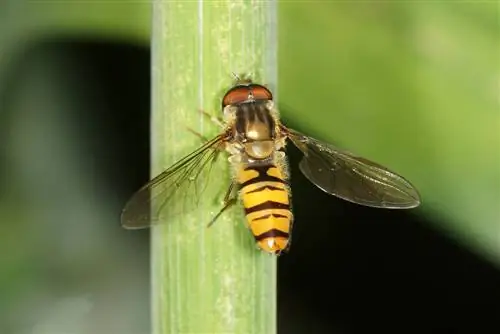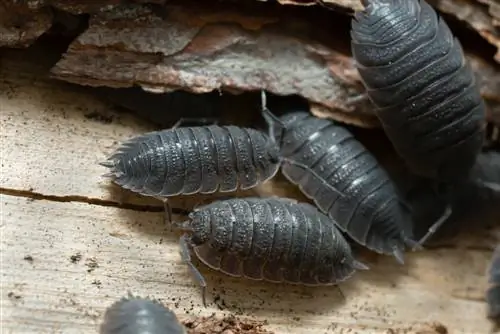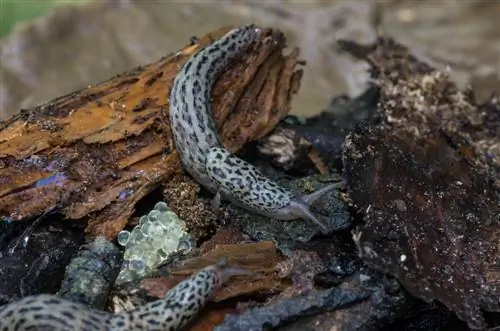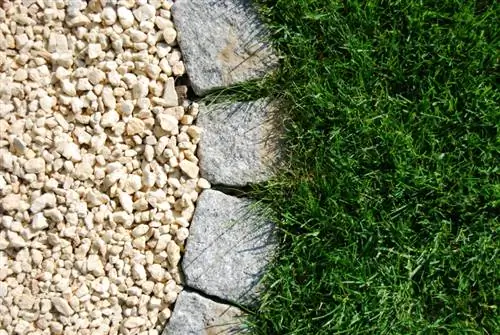- Author admin [email protected].
- Public 2023-12-24 06:09.
- Last modified 2025-06-01 06:02.
She's not exactly one of the most popular residents. The animal lives in secret and rarely shows itself. Wherever it occurs, fear and disgust spread. But anyone who takes a closer look at the way of life of the large angle spider will be amazed.
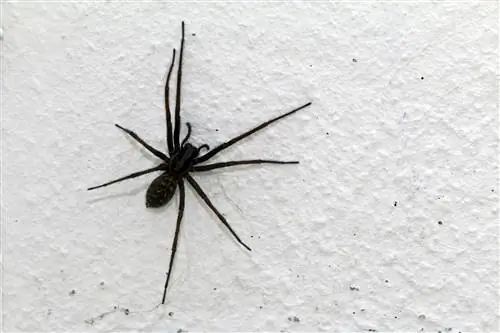
Dangerous and poisonous?
Eratigena atrica is one of the completely harmless species that does not show any aggressive behavior towards humans. If they are disturbed in their burrows, they leave them and flee. In the event of major disturbances, the animals abandon their previous nest and look for an alternative hiding place.

Do angle spiders bite?
It occasionally happens that people are bitten by the large angle spider. However, this behavior is the big exception, because even scientists need a lot of patience to get the animals to bite. Their mouthparts can only penetrate thin layers of skin, which is why a bite is noticeable but harmless. In the worst case scenario, the poison leads to slight redness, burning and itching. The symptoms automatically disappear in one to two hours. A mosquito bite is much more unpleasant.
Don't be afraid of the large angle spider! The animals are completely harmless and would rather run away than bite people.
What are the benefits of angle spiders?
The animals have an important function in the ecosystem because they keep the populations of small insects in check. Their menu includes numerous human pests such as woodlice, flies and mosquitoes. This is how they keep houses and apartments clean.
Their appearance does not indicate unhygienic conditions, as the angle spider prefers warm and dry habitats and avoids damp basements or bathrooms. At the same time, angle spiders provide an important food source for larger insectivores. They are preyed upon by various birds and bats.
Dispel and keep away
The easiest way to keep spiders away is fly screens. If you make sure that all gaps under entrance doors and windows are closed, access will be made much more difficult for animals. If angle spiders have found their way into your home, simple measures can help.
Tip
Don't suck in the spiders. In the vacuum cleaner bag, the animals suffer a painful death from suffocation.
Essential oils
Angle spiders detest intense smells. You can effectively scare away the animals with scent lamps so that they look for a new hiding place. You can make a solution with ten drops of oil, a splash of dish soap and 450 milliliters of water that you can apply to entry points as a repellent. This means that the spiders cannot find access to your apartment.
Alternatively, you can also distribute lavender sachets on doors and windows. If you have cats, you should avoid this measure. House cats react sensitively to essential oils.
Suitable substances:
- Neem, lavender and tea tree oil
- Citrus fruits
- Peppermint or cinnamon
Glass
The easiest method to remove is a tall glass. Put this over the spider. Slight movements trigger the escape reflex, causing the animal to jump away from the ground. With one quick movement you caught the spider in the glass. She is unable to climb out of the smooth walls and can then be released outdoors.
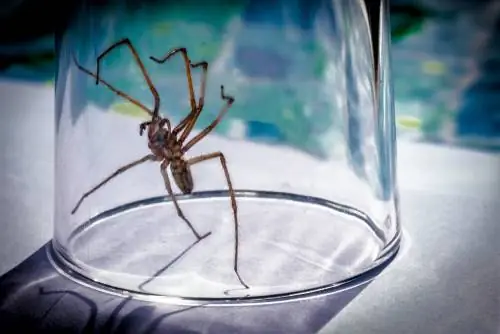
You can easily catch spiders with a glass
Tip
Put the spider far away from the house so that it can't find its way back. A pile of wood is perfect because the animal can find alternative retreats here.
Profile
The giant house spider is one of the species from the genus of angle spiders native to Central Europe. It has the scientific name Eratigena atrica, but is sometimes referred to as Tegenaria atrica. This species is the largest spider that can be found in houses in this country. Their frequency is influenced by weather conditions. The species prefers warm temperatures.
Large Angle Spider - Systematics:
- Arthropods: belongs to the molting animals
- Real web spider: hunts with webs
- Funnel spider: builds caves
“House spider”
It's not just the large angle spider that is called a house spider. Some other species of the genera Eratigena and Tegenaria also have this nickname because they prefer to be found in sheds and barns but also in houses and apartments.
| scientific | Dissemination | Special features | |
|---|---|---|---|
| House angle spider | Tegenaria domestica | temperate latitudes | indistinctly ringed legs |
| Wall Angle Spider | Tegenaria parietina | Southern Europe | Wingspan up to 14 cm |
| Rust Angle Spider | Tegenaria ferruginea | scattered in Central Europe | Abdomen rusty red jagged |
Appearance
The spider reaches a body size of between ten and 20 millimeters. Females and males can only be distinguished by their size with legs. The wingspan can be up to ten centimeters. The larger females are similar to the male animals in basic color and markings.
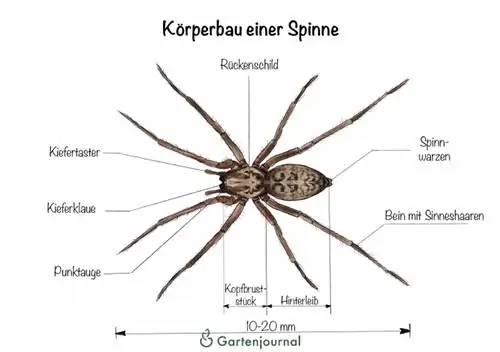
Coloring
This is predominantly dark brown, although a light brown marking in the shape of a club can be seen on the chest plate. The narrow end of the club extends towards the abdomen. Three light brown spots can be seen on either side of this drawing. These converge in a radial pattern and become smaller towards the front and back. A narrow, light central stripe can be seen on the rear body segment. There are six angular spots on the side of this drawing, which is why the species are called angle spiders. These spots partially merge with the median strip.
Physique
Anal opening and spinnerets are located on the underside of the abdomen. The breathing gap and genital opening are located a little further forward. The legs are a solid light brown and covered with dense bristles and fine hairs. In the large angle spider, the front pair of legs is the longest, while the legs become shorter towards the back. In females the legs are twice as long as in males and three times as long.
Excursus
Good runners but bad climbers
With this specially designed walking apparatus, angle spiders can reach impressive speeds. They can cover a distance of 50 centimeters per second. However, they don't keep up this pace for long. The movements are created hydraulically by the forebody generating pressure. This stretches the legs. The walking apparatus is not suitable for climbing because, unlike many other spiders, the hairs hardly generate any adhesion forces. This makes smooth surfaces an insurmountable obstacle.
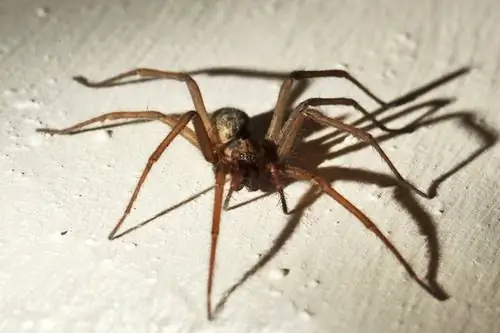
The Great Angle Spider is amazingly fast
Senses
The bristles and hairs are the spiders' most important sensory organ. This means they can detect even the slightest vibrations or low-frequency sounds. The large angle spider has eight eyes of the same size, which are arranged in two rows one above the other and are directed forward. However, their sense of vision is not well developed and is limited to the perception of light and dark contrasts. The individual eyes contain fewer than 400 visual cells.
Confusion
The large angle spider can easily be confused with other species from the same genus. A good distinguishing feature is the bristly and finely hairy hairs, as other Eratigena species often have ringed or spotted legs. In order to clearly identify the species, researchers examine the markings on the chest, sexual organs and the internal structure of certain head extremities, the so-called pedipalps or jaw palps.
These angle spiders have solid colored legs:
- Large angle spider (Eratigena atrica)
- the slightly smaller Eratigena picta
- the darker field spider (Eratigena agrestis)
Lifestyle and behavior
The species is nocturnal and builds its web primarily in less disturbed areas of the house. The net is designed in the shape of a funnel, the opening of which tapers towards the end. The spider stays in this cave and waits for prey. Catching threads extend from the net in all directions in which passing insects get caught.
Dwelling caves are abandoned when they are destroyed or the food supply in the area becomes scarce. In some cases, abandoned nests are repopulated and in rare cases the spiders conquer funnel webs that have already been inhabited. Above all, the superior females drive away or kill the smaller males in order to take over their den.
Reproduction and development
In late summer, the males go on forays to track down females that are ready to mate. The males can be recognized at this time by their significantly enlarged pedipalps. Depending on the weather, the mating season can also move into autumn. Low temperatures severely limit mating activity.
Courtship
Male slowly approach a female, drawing attention to themselves by movements of the front pair of legs and jaw palps. Extreme caution is required here, because if the female is not willing to mate, she will kill the male. It may take several hours for mating to complete. This is repeatedly interrupted by peaceful pauses.
This is how communicative mating behavior is:
- Male continuously knocks and tugs on the female's net
- If successful, female falls into mating paralysis
- Male can then complete copulation
Eggs
One month after successful mating, the female produces a white cocoon made of fine spider silk in which the eggs are located. It spins up the living hole in order to attach the egg cocoon to web ribbons arranged in a star shape. A cocoon can contain between 50 and 130 large eggs. After the young hatch, they spend the next few months in the protection of the nest. They won't leave the web until next spring.
molting
Until the angle spiders have reached their full size, they shed their skin several times. Shortly before a molt, the animals turn dark to almost black. Eventually the breastplate breaks open and the spider wriggles out of the old skin covering, which has now become too tight. During molting, the outer skin is renewed and the spiders gradually become larger. Once it has shed its old skin, the body is extremely soft and has to harden again. During this time the animal rests in its hiding place.
Skin change in a nutshell:
- Skin consists of two layers of chitin
- the inner layer forms anew before molting
- then the outer shell breaks
- new skin is formed by secretions
Lifespan and Dangers
Not all young animals survive the winter. Numerous animals fall victim to cold or damp weather combined with the spread of fungi. Others are bitten by hatchlings and eaten by their later hatching larvae.
The animals that survive the winter grow into adult angle spiders within two months. These usually reach an age of two to three years. In rare cases and under very favorable conditions, life expectancy is up to six years. One of the most dangerous enemies of adult animals is the large trembling spider. She has developed a special catching technique that allows her to capture much larger spiders.

The large angle spider lives up to three years
Distribution and habitat
The distribution area of the species extends across Europe. It occurs in Central Asia and North Africa and was introduced to North America. Here too, the species was able to establish itself quickly because it finds optimal hiding places in houses and apartments with dry and protected conditions. The large angle spider occurs at altitudes of up to 800 meters.
Preferred habitats
In nature, the species lives in dry and warm caves that are close to the ground. It uses tree hollows at low altitudes primarily in old deciduous forests, but is also found in tunnels and buildings. Wine-growing regions offer optimal conditions. Here the spider inhabits burrows under hedges and bushes as well as ruderal sites. Humid habitats and higher-lying habitats are avoided.
In the house
When it gets colder outside, angle spiders look for a warm and protected hiding place. This drives the animals into human habitations, especially in autumn. When they lay their egg cocoons and hatch young in dark and protected corners, the impression of a sudden spider invasion quickly arises.
Angle spiders in human habitations:
- dry basement rooms
- in apartments behind cupboards
- Barns and Sheds
Food
The large angle spider does not produce glue threads. It is one of the lurking hunters that rushes out when the net is shaken and quickly grabs its prey. This is killed with a bite, whereby digestive enzymes and proteins are injected into the organisms. This causes the prey to decompose internally and the spider can suck up the liquid pulp with its jaw claws. The food is not eaten in the den but outside the nest. Their diet mainly consists of insects and woodlice.
Keep as a pet
The large angle spider is well suited to keeping in a terrarium because it requires little care and is quiet. Spider lovers enjoy the delicate webs of angle spiders. They can even help manage fear of spiders. However, avoid capturing animals from nature. They feel more comfortable in their natural surroundings. Female animals are better suited to keeping as males live shorter lives and cannot rest in the terrarium.
This is what you need to pay attention to
All containers made of glass or plastic are suitable as breeding containers. The large angle spider does not require much space. The larger the container, the more nests it builds. This does not necessarily have to be covered. However, the spider can climb up the walls on even the smallest pieces of dirt and escape. There are special fauna boxes or cube terrariums that offer the animals optimal living conditions. Square containers are more suitable than round glasses because the spiders can easily attach their webs in corners.
For successful breeding:
- Fill the floor with sand, wood and stones
- spray water into the funnel net every two days
- All insects or crickets are suitable for feeding
Frequently asked questions
What does the large angle spider eat?
The diet of this species includes various insects that move by crawling or flying. If a prey animal comes across the catching threads, the spider is alerted. She comes out of her hiding place and catches the prey with her powerful jawed claws. Annoying mosquitoes, flies or woodlice are killed with one bite. The spider injects a digestive secretion into the organism so that it is pre-digested from the inside. All she has to do is suck up the liquid pulp.
How many insects do spiders eat?
The number of insects eaten by spiders is impressive. All spiders in the world taken together eat between 400 and 800 million tons of insects and small animals every year. This sum even exceeds the consumption of meat and fish caused by the world population each year. Together, people eat around 400 million tons per year.
Is the large angle spider dangerous?
There are reports that people have been bitten by the animal. However, the bite is harmless to humans. Redness and itching subside after a short time. It is very rare for spiders to bite and their mouthparts have difficulty drilling into human skin. They usually flee when threatened and look for an alternative hiding place instead of attacking.
Where does the large angle spider live?
The species is widespread throughout Europe. In nature, the spider lives near the ground. It relies on dark and protected caves, avoiding damp habitats. Since there are optimal hiding places close to people, the large angle spider can often be found in apartments. In autumn she goes looking for a suitable place to retreat because cold temperatures are suboptimal.
How old does the large angle spider get?
The life expectancy of spiders depends not only on the weather conditions but also on enemies. Many young animals do not survive their first winter. They fall victim to cold temperatures and die when fungi spread in too moist hiding places. If the young animals have survived the winter, they can live for two to three years. They rarely have a life expectancy of six years.
What enemies does the Great Angle Spider have?
The natural enemies that can also appear in the home include parasitic wasps. The insects lay their eggs in the young spiders. When the larvae hatch, they eat the animals from the inside. Humans are also one of the greatest enemies of the large angle spider. Fearful people resort to vacuum cleaners or slippers to get rid of the spider. However, it is better to catch the animal with a glass and take it outside.


